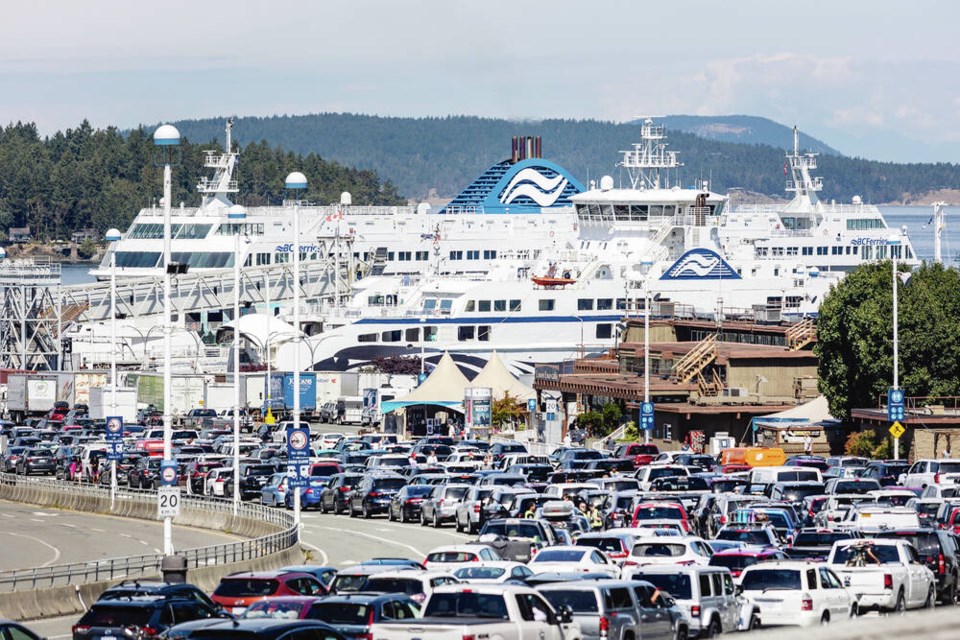B.C. Ferries’ fares are set to rise an average of 3.2 per cent a year for four years, starting April 1, although actual increases must still be determined and are expected to vary by route.
The final price-cap announcement from the B.C. Ferries Commissioner came Tuesday, after the province provided $500 million to stave off feared double-digit-percentage increases.
The cap is the maximum overall increase allowed for passenger and vehicle fares and reservation fees, and does not affect fuel surcharges, parking costs or retail and food .
Commissioner Eva Hage said that without the extra government money, the average annual price cap would have come in at 9.2 per cent.
“A maximum 3.2 per cent increase in annual fares will, I believe, be sufficient to allow B.C. Ferries to meet the financial demands of the upcoming performance term, while at the same time providing British Columbians with safe, reliable and affordable ferry service,” she said.
But Hage warned that double-digit fare increases may still be on the horizon without another chunk of government funding, noting that B.C. Ferries faces servicing costs for long-term debt, estimated to double to $3 billion by 2028.
“While the government’s additional $500 million has allowed us to cap fare increases in line with inflation for the next four years, we must remember that this is one-time funding,” Hage said. “The cost to operate the ferry system is increasing and will continue to increase at a rate higher than inflation.”
Hage’s price-cap decision stipulates that B.C. Ferries must prepare a plan outlining how it will track actual capital expenditures against the forecast submitted to the commission, and how it will measure the cost and service effectiveness of its investments in human resources.
The ferry system is a capital-intensive business, Hage said, and assets have to be replaced in a timely way to offer safe and reliable service.
Plans to replace six major vessels and add another are leading to a “significant spike in capital expenditures” in the coming four years, she said.
When Hage sets the price cap, which happens every four years, she is charged with determining how much revenue is needed to cover the system’s operating costs and debt servicing. Expenses include fuel, labour costs and capital plans.
Under the province’s renewed service contract with B.C. Ferries, which sets out minimum service levels between April of next year and March 2028, 1,433 extra round-trip sailings will be offered on 13 minor routes, the province said. These were previously described as discretionary sailings and not required under the agreement.
In March, the commissioner released a preliminary price cap of 9.2 per cent for each of the next four years. But that was quickly quashed by company chief executive Nicolas Jimenez, who said the final rate would not be that high, after the province said it would add funding to keep fare increases closer to three per cent annually.
The province’s annual service fee to B.C. Ferries is $194 million.
Looking to the future, Hage said she’s concerned about a “steep increase in operating costs” and the “ability of the corporation to manage its costs in line with the forecast.”
She sees a “significant risk” to the corporation’s capital plan in the event of cost overruns and schedule delays.
Operating costs are forecast to be 40 per cent higher by the 2025 fiscal year than the 2022 fiscal year.
Hage noted that the company showed a slightly improved financial position in summer compared with spring, largely because of deferred capital spending and higher earnings from interest income.
Higher traffic boosted customer revenues by $15 million, but that was offset by higher labour and maintenance costs of $17 million.
Over the next four years, B.C. Ferries anticipates that operating costs will be $62 million more than earlier expected.
Capital expenses over that time period are expected to be higher by $97 million.
Hage urged the company to find “innovative efficiencies,” given increases in labour costs in the past three years because of staff shortages, absenteeism and overtime expenses.
A global shortage of skilled mariners combined with higher wages offered by other employers is putting wage pressure on B.C. Ferries. The union representing ferry workers has been in wage talks
Jimenez said Hage raises important concerns around pressures facing the ferry system because of rising costs and the need to renew assets.
He said B.C. Ferries is “actively working” to increase its capacity to deliver on its capital plan over the longer term, “as it is clear that significant investment is required in vessels, terminals and [information technology] systems to meet the public’s expectations of a modern ferry service.”
>>> To comment on this article, write a letter to the editor: [email protected]




